Antec Eleven Hundred: The P280's Gloves Come Off
by Dustin Sklavos on April 9, 2012 12:00 AM EST- Posted in
- Cases/Cooling/PSUs
- Antec
- mid-tower
Noise and Thermal Testing, Overclocked
The Antec Eleven Hundred put in a strong showing with our stock settings, clearly offering a substantial amount of thermal headroom right from the factory. Hopefully the more open-air design will continue to pay dividends once we jack up the voltage on the CPU and the graphics card and overclock them both.
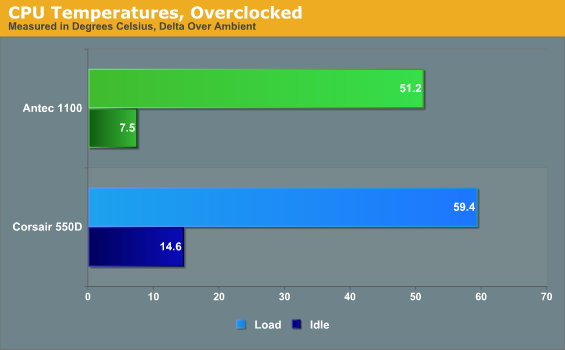
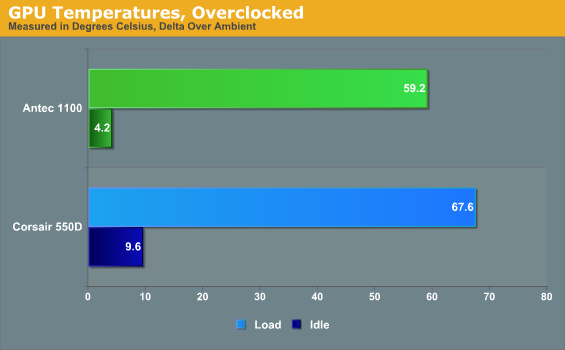

Antec's enclosure separates a lot more from Corsair's acoustically-oriented design once overclocks are applied, as the major components run much cooler at both idle and load. That's to be expected; the Eleven Hundred already proved it had plenty of thermal headroom and even here that continues. Ambient temperatures during testing hovered around 23C; if you do the math, even in a room that's pushing 90 degrees Fahrenheit (32C), the Eleven Hundred should still keep the components running well below spec temperature.
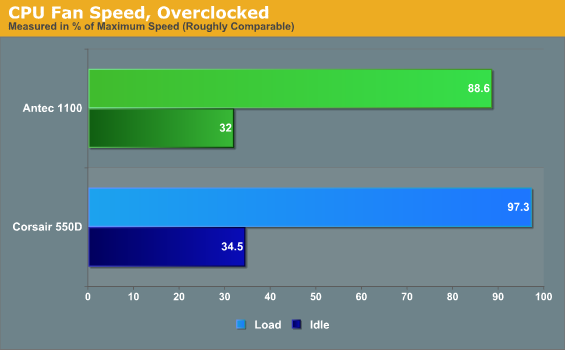
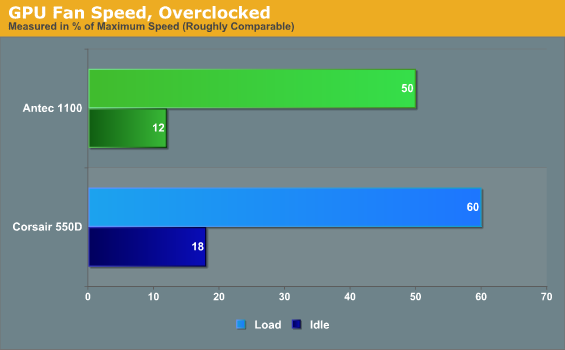
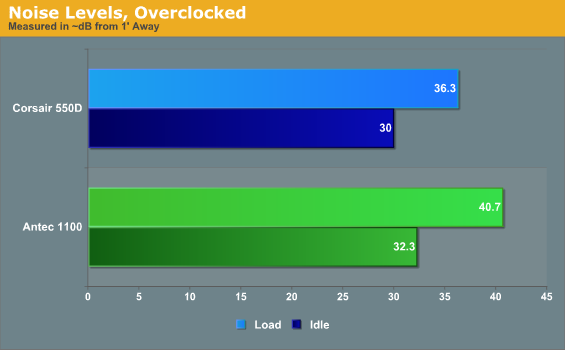
That headroom is borne out again when we look at fan speeds; while the Corsair 550D's more closed-off design results in our cooling system beginning to hit its limits, the Antec Eleven Hundred still has a bit more to go.
I don't intend to denigrate the 550D's thermal performance, though, because when you take a look at our noise levels you see where the 550D's strengths lie. The Eleven Hundred becomes very noticeable when stressed while the 550D does a better job of keeping a lid on the parts. Those fans may be working harder, but they're still ultimately working quieter in Corsair's case. This is the tradeoff users routinely have to make if they're not willing to spend up on something beefier like SilverStone's FT02 or Cooler Master's Cosmos II.










40 Comments
View All Comments
Sabresiberian - Monday, April 9, 2012 - link
Uh, if you don't get why the side vents are there, YOU are the one that's stupid, not Antec.Iketh - Monday, April 9, 2012 - link
no no no... if you are still using side vents, YOU are stupidJarredWalton - Monday, April 9, 2012 - link
Yay for intelligent arguments!The reason some people like side vents is that if you have two GPUs, especially on a motherboard where they're only two slots apart (e.g. a "GPU sandwich"), putting a couple fans right above the GPUs can be very helpful for temperatures. From a noise and dust standpoint, though, it's not a good thing and aesthetically some will dislike panels as well.
Sabresiberian - Monday, April 9, 2012 - link
It''s you, the case isn't ugly at all to me.Some people think their concept of beauty in a case should rule over every case a company makes, but, hey, there's a reason that Antec makes so many different types of cases (as well as other manufacturers).
;)
dtolios - Monday, April 9, 2012 - link
What's the point of getting a large or mid-expensive range case to combo with mATX again? I don't understand why "enthusiast" oriented cases should be tested using an mATX mobo the first place....ofc it can do mATX and one GPU...big deal...can it do 2x large GPUs and full ATX good enough is always a WAY more valid question - both for an organizational and thermal performance standpoint.Guess it is just me...
ClockHound - Monday, April 9, 2012 - link
Would it be too much to ask for proof reading before publishing?"If you'll let me beat this dead horse one last time, I'm keen to point out what the Antec Eleven Hundred is that the Antec P280 isn't: a cheaper P280."
I'm keen to understand what you meant. Does this mean that the P280 isn't a cheap P280 or did you mean that the Eleven Hundred isn't a cheap P280? And how did the Three Hundred get into the review text? It's in the text of the overclock page.
I do agree the delta is the better number to display....but it does beg the question with this new test system, why you can't test in a temperature-controlled environment? Why not test with different ambient temps, like room temperature and a 'hot' room temperature?
Thanks for the review.
JarredWalton - Monday, April 9, 2012 - link
Reviews do get proofed most of the time (by me for Dustin's reviews), but I try to take a hands off approach and I thought initially he was trying to say something else. I've fixed that. Anyway, while you're happily flogging us for minor typos, you might want to research what it means to "beg the question". ;-)As for the temperature controlled testing environment, it would be awesome to have such equipment, but we don't. Environmentally regulated test environments don't come cheap, and they also pose a different problem: 70F ambient without a lot of airflow from the AC isn't the same as 70F with an AC moving quite a bit of air. The difference may not be that large, but I'd bet it would be measurable.
Sabresiberian - Monday, April 9, 2012 - link
I get trying to keep the quality of Anandtech high, and I think that pointing out errors in communication is appropriate, but you would make a better point by making a post that is free of spelling, grammar and usage errors itself.;)
kevith - Monday, April 9, 2012 - link
Why don't you ever bother to experiment a bit with different numbers and placement of fans? In this case, it would have been VERY interesting to know, what impact that fan behind the motherboard has on temps. AND noise, since it's tugged away far from the user. And there's a lot of other empty fan placements, that, filled up with fans might change the performance and accoustics. But I guess I'l have to buy the case to find out. (And what's the purpose of reading reviews then...?)You'l probably say, that writing a review takes a lot of time, even without digging deeper into fans, their numbers and placement. But why use all that time, and then in the end the review is only half? Who wants to do or read something, that's ALMOST great? The vast majority of people, that would consider buying this case - and other hi-end cases - will definitely want to experiment.
Aand then you spend a lot of time comparing the P280 and the 1100. Except for readings...!? Why don't you show the figures of the P280 in the graphs?
And I don't think you understood Stahn Aileron's question: We all know, why you changed to showing Delta over ambient, but please let us know what the ambient is, so we know how hot the thing is.
PhoenixEnigma - Monday, April 9, 2012 - link
If you read the review, it's noted that the ambient temperature was about 23C for these tests. The 550D was apparently tested in a room about a degree cooler.Of course, it would make more sense for the reader to use their own ambient temperature - that's the advantege to having the delta and not the final number, it's easier to adjust for your conditions.